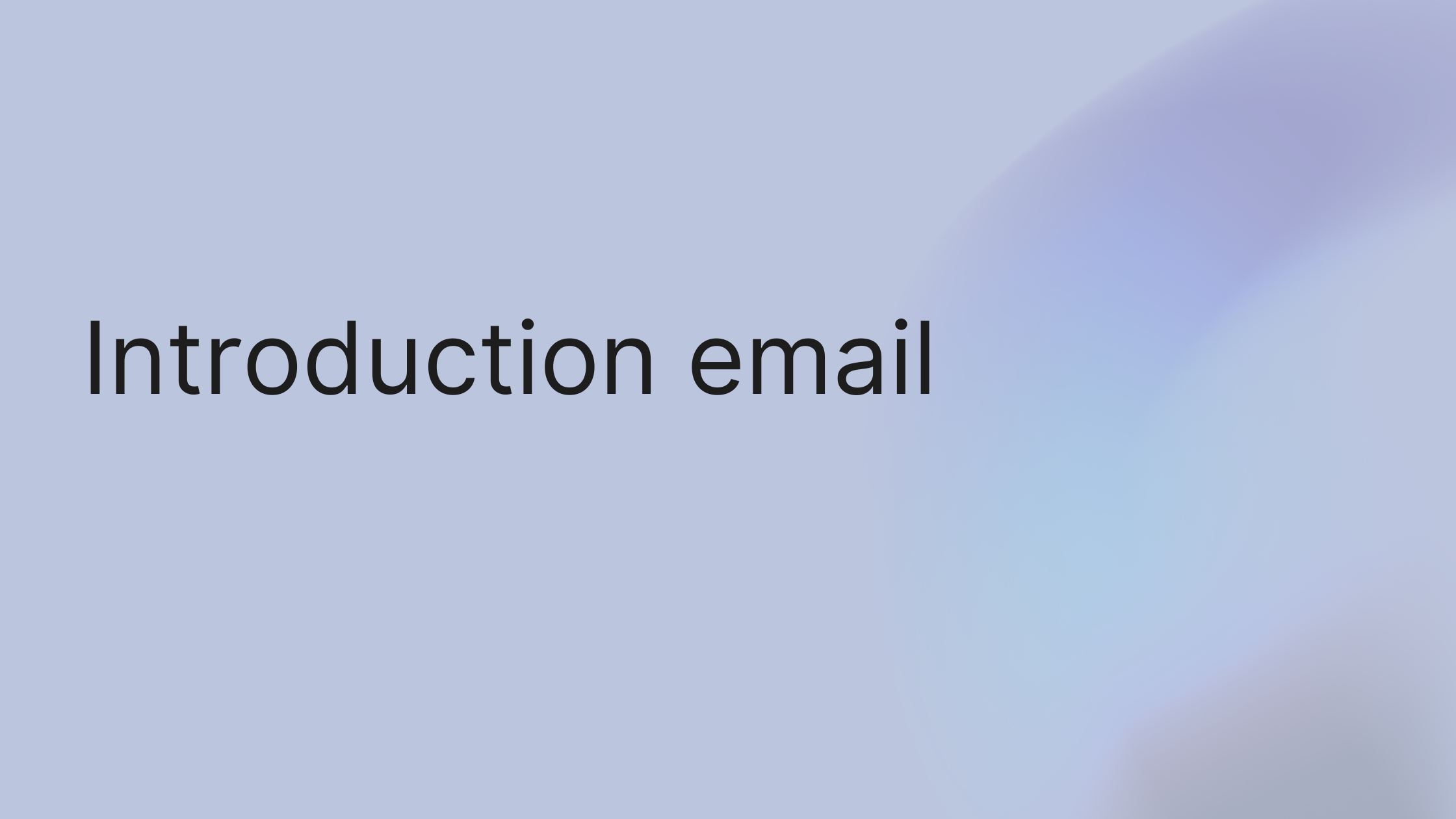Staring at a blinking cursor, trying to figure out how to email a complete stranger without sounding desperate? We've all been there. Here’s the quick win: the best introduction emails aren't about what you want, they're about what you can give. A powerful introduction isn't a sales pitch; it's the start of a real relationship.
Why Your Introduction Emails Land in the Digital Void
If your outreach is hitting a wall of silence, it’s not bad luck—it’s a flawed strategy. Most ignored emails fall into the same traps: they’re generic, self-serving, and immediately create work for the recipient.
Think about it. Emails that jump straight to asking for a meeting or a sale—without first showing you’ve done your homework—are begging to be deleted. You have to earn their attention first.
The fix? Flip the script. Before you write a single word, put yourself in their shoes. What are they trying to achieve? How can you offer a genuine piece of advice that helps them? This simple, actionable shift changes the entire dynamic.
This step-by-step workflow is key:
- Define Your Goal: What do you want to achieve?
- Understand Your Audience: What are their pain points and goals?
- Draft with Value: Write an email focused on helping them.

Following this process forces you to build a foundation of relevance before you hit "send." It guarantees your email is strategic, not just another piece of junk clogging their inbox.
Of course, a perfectly crafted email is useless if it never arrives. Make sure your technical setup is sound by reviewing our guide on how to improve email deliverability.
Read your draft out loud and ask, "If I received this, would I be impressed or annoyed?" If the value isn't crystal clear in the first two sentences, it's time for a rewrite. The best introductions feel like a gift, not a request.
Here's a quick reference to keep these core ideas top of mind.
The High-Impact Introduction Email Framework
| Component | Purpose | Example Snippet |
|---|---|---|
| Personalized Opener | Show you've done your homework, you're not spamming. | "Loved your recent podcast episode with Jane Doe..." |
| Value Proposition | Clearly state what's in it for them, not you. | "I noticed your new landing page could see a 20% lift with one small tweak..." |
| Credibility Signal | Briefly explain why they should listen to you. | "We helped a similar company in your space achieve..." |
| Low-Friction CTA | Make it incredibly easy to say yes. | "Is this something you're curious to learn more about?" |
This framework isn't about rigid rules, but about building a habit of leading with value. I once saw a designer land a dream gig by sending a marketing director a single, unsolicited slide with an idea to improve their latest campaign. No ask for a job, just pure value. The director replied within an hour. That’s the power of this approach.
Crafting a Subject Line That Demands a Click

Let's be honest. That blinking cursor in the subject line field is intimidating. It’s the most critical part of your email, yet it’s often an afterthought. Here’s an actionable mental shift: stop thinking "subject" and start thinking "headline." Your job isn't to summarize; it's to spark curiosity.
The data doesn't lie. Personalizing a subject line can boost open rates by 50%. Even just using the recipient’s name gives you an edge. Studies also show including "video" can increase open rates by 19% and click-through rates by 65%.
Actionable Subject Line Strategies
If your go-to is "Quick Question," it's time for an intervention. To a busy professional, that screams "generic sales pitch." Instead, your subject line needs to prove you have something genuinely valuable to say.
- Lead with a Mutual Connection: "Jane Doe suggested I get in touch" instantly builds trust.
- Acknowledge a Recent Win: "Congrats on the recent funding round" shows you’re paying attention.
- Ask a Specific, Relevant Question: "A question about your content strategy" is direct and intriguing.
Mini-Case Study: The Subject Line That Booked a Meeting
An agency I know was trying to connect with a VP of Marketing at a hot tech startup. Instead of the usual "Intro from XYZ Agency," they did some digging and found a press release mentioning an upcoming initiative.
Their subject line: "An idea for your upcoming 'Project Titan' launch."
The result: The VP opened it, replied, and booked a meeting. Why? The subject line proved they were invested observers, not just another name on a contact list. This kind of targeted approach is a cornerstone of great client communication best practices.
Now that you've got their attention with a killer subject line, the body of your email has to deliver on the promise.
Structuring Your Email Body for Maximum Impact

Your killer subject line did its job. They clicked. You now have just a few seconds to prove opening your email was the right move.
The secret isn’t prose; it’s a clean, scannable structure that gets right to the point. Every great introduction email boils down to three key steps: a hyper-personalized opening, a clear value proposition, and a simple, low-effort call to action.
Step 1: Nail the Opening Line
Forget generic openers like "Hope you're having a great week." Your first sentence has one job: to prove this email was written specifically for them.
This is where doing your homework pays off. Reference something specific:
- A recent company achievement: "I was seriously impressed with the case study you published on the Acme Corp rebranding."
- Something they shared online: "Your recent LinkedIn article on the future of AI in marketing really hit home."
- A common connection: "As a fellow enthusiast of mid-century design, I loved the aesthetic of your new website."
A simple observation like this instantly separates you from 99% of the other emails in their inbox.
Step 2: Clearly State Your Value
You've got their attention. Now quickly answer the question in their head: "What's in it for me?" This is not the time for long-winded paragraphs. Draw a straight line from what you offer to a direct benefit for them.
Real-World Example: We needed to connect with a busy marketing manager. Instead of listing services, we wrote: "I noticed your team is hiring for three new marketing roles. Onboarding new clients while scaling a team is a huge challenge. Our platform helps agencies streamline this exact process, saving them an average of 10 hours per week."
This worked because it zeroed in on a real pain point (hiring and scaling) and offered a concrete solution (saving time). A great email should feel as seamless as great client onboarding best practices.
Step 3: Craft a Low-Friction Call to Action (CTA)
One of the biggest mistakes is a demanding CTA like, "When are you free for a call?" That puts the work on them.
Instead, use a simple, interest-based question that makes it easy to say "yes."
- "Would you be open to a 15-minute chat next week to explore this?"
- "Is improving [their goal] a priority for you right now?"
For a deeper dive, explore advanced email marketing strategies for higher conversions.
A Real-World Example That Actually Worked
It’s one thing to talk theory, another to see it in action. Getting a response isn't magic. It's a simple, repeatable formula: genuine personalization, real value, and a light-touch call to action.
Let's walk through an actual email our team at growlio sent. This was a single, thoughtful email to an industry influencer that opened the door to a fantastic partnership.
Breaking Down the Winning Email
Here’s the anonymized version of the exact email we sent:
Subject: An idea for your recent SaaS Metrics podcast
Hi [Influencer's Name],
I’m a long-time listener of your SaaS Metrics podcast—the recent episode with Jane Smith on cohort analysis was fantastic. Your point about tracking net revenue retention really stuck with me.
I noticed you often discuss the challenge of managing client projects alongside growth. We found that most agencies struggle to keep client info organized, which directly impacts their ability to scale. We actually put together a guide on creating a streamlined clients information sheet that your audience might find useful.
No pitch here—just a fan of the show with a resource that might help your listeners. Keep up the great work!
Best,
The growlio Team
Why Did This One Get a Reply?
- Personalized Hook: We showed we were actual listeners. Referencing a specific episode and key takeaway proved we'd done our homework.
- Clear Value Proposition: We never mentioned our product. Instead, we identified a pain point they often discuss and offered a genuinely helpful, free resource.
- No-Pressure CTA: "No pitch here" was intentional. It took all sales pressure off the table, making it easy to reply.
Let's be real: cold email response rates are notoriously low, around 8.5%. But data shows that slightly longer emails (100-150 words) packed with value perform much better. And referencing a shared connection can boost your reply rate by as much as 45%. You can dig into more cold email statistics to see the full picture.
Advanced Tactics to Optimize Your Outreach

So, you’ve sent your intro email. Now what? Waiting for a reply is frustrating. To build momentum, stop thinking in single emails and start thinking about a strategic sequence. This simple shift turns a one-off attempt into a professional campaign.
Test and Automate Your Way to Better Replies
The best outreach pros share a mantra: always be testing. Constantly run small experiments to see what resonates. This is where A/B testing subject lines and calls-to-action (CTAs) proves its worth.
Data backs this up: 65% of marketers prioritize personalizing subject lines, and 43% rely on A/B testing. Even a small tweak like adding preheader text can bump open rates from 39.28% to 44.67%.
Once you've nailed a single email, scale your success with powerful email sequence templates to guide your communication flow.
Pro Tip: The Art of the Follow-Up Sequence
A great follow-up isn't just a re-send. It’s a gentle, value-added nudge.
- Timing: Wait 3-5 business days between emails.
- Follow-Up #1: A quick, "Bumping this up in your inbox."
- Follow-Up #2: Offer something new—a relevant article, a case study, or a useful tip.
This approach shows persistence without being pushy. In growlio, you can automate this entire process by building personalized sequences that react to what your recipient does. For example, you can set a trigger to send a follow-up if there's no reply after 4 days. This saves time and ensures no lead falls through the cracks.
So, Where Do You Go From Here?
Staring at that blinking cursor feels like a roadblock. But the real breakthrough comes when you stop searching for a formula and start thinking about the person on the other end.
A great introduction is a skill. It’s built on providing value first, wrapped in a subject line they can't ignore, a personalized body that shows you did your homework, and an easy ask. You have the roadmap to go from being just another unread email to starting a real conversation.
I saw this firsthand with a design studio we worked with. They were stuck sending generic "Intro from [Studio Name]" messages. We had them switch gears. They started referencing a prospect's recent project launch and offered one specific, actionable design tip. The result? Their reply rate tripled in a month. It works.
If you're looking to see how these touchpoints fit into a bigger picture, it's worth exploring SaaS email marketing strategies to understand the long-term game.
Now, it's time to put what you've learned into motion. Start your free growlio.io account and begin building connections that move the needle for your business.
A Few More Questions About Introduction Emails
Even with the best templates, a few tricky questions always pop up. Let's clear up some of the most common ones.
How Long Should an Intro Email Be?
Keep it short and sweet: 75 to 150 words. Any longer, and you risk your main point getting buried. A concise, scannable email shows you respect their time.
When Should I Follow Up?
You sent the email and… crickets. It happens. The sweet spot for a follow-up is about 3 to 5 business days. Your second email should be even shorter—just a gentle nudge referencing your original message.
Are Templates a Bad Idea?
Not at all! Templates are fantastic for structure. The mistake is using them as-is.
A template gives you the bones; personalization gives it a heartbeat. Always customize your opening and value proposition to reflect what you know about the person you're contacting.
I once saw a sales rep land a massive account by mentioning a tiny detail from the prospect's recent appearance on a niche podcast. That single, personalized line did more to build trust than a dozen generic "value props" ever could. It proves you aren't just blasting out spam.
Ready to move from theory to action? You can put all these strategies to work with growlio. Start your free growlio.io account and see for yourself how genuine outreach can build connections that truly matter.
